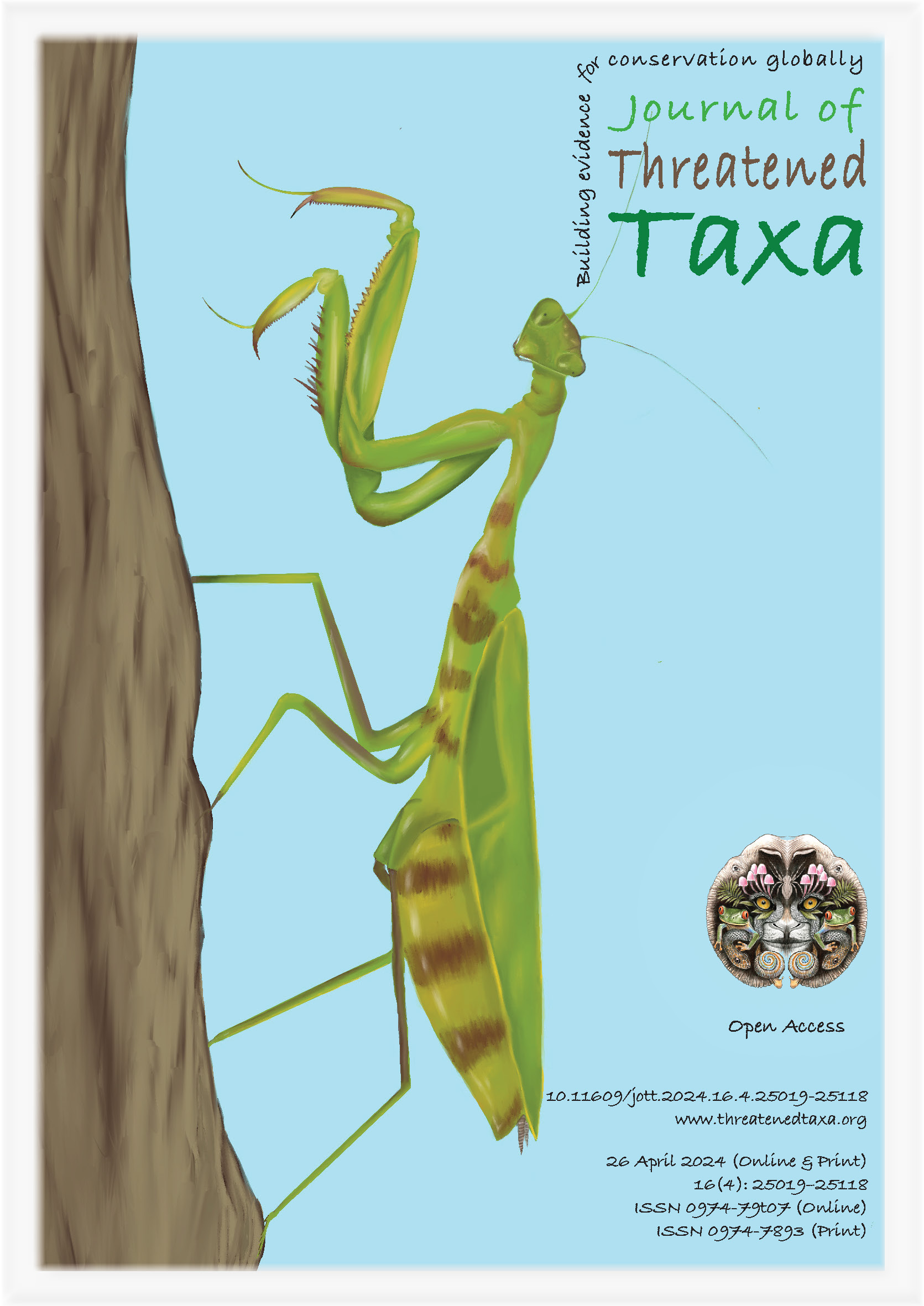First record of the phoretic association between Pediculaster sp. (Pygmephoridae) mites and Musca crassirostris (Muscidae) flies in India
Main Article Content
Abstract
This article reports for the first time a phoretic pygmephorid mite on a muscid fly from India, with pygmephorid mites classified under the order Prostigmata and the family Pygmephoridae. The mites, identified as species of the genus Pediculaster belonging to the family Pygmephoridae, were collected in July 2019 from Khajjiar town, located in the Chamba district of Himachal Pradesh, India. The flies, identified as Musca crassirostris belonging to the family Muscidae, were also noted. While this study marks a significant step in Indian research, further investigation is warranted to comprehensively compile data on the species accuracy of mites and their habitat preferences.
Article Details

This work is licensed under a Creative Commons Attribution 4.0 International License.
Authors own the copyright to the articles published in JoTT. This is indicated explicitly in each publication. The authors grant permission to the publisher Wildlife Information Liaison Development (WILD) Society to publish the article in the Journal of Threatened Taxa. The authors recognize WILD as the original publisher, and to sell hard copies of the Journal and article to any buyer. JoTT is registered under the Creative Commons Attribution 4.0 International License (CC BY), which allows authors to retain copyright ownership. Under this license the authors allow anyone to download, cite, use the data, modify, reprint, copy and distribute provided the authors and source of publication are credited through appropriate citations (e.g., Son et al. (2016). Bats (Mammalia: Chiroptera) of the southeastern Truong Son Mountains, Quang Ngai Province, Vietnam. Journal of Threatened Taxa 8(7): 8953–8969. https://doi.org/10.11609/jott.2785.8.7.8953-8969). Users of the data do not require specific permission from the authors or the publisher.
References
Athias-Binche, F. (1994). La phore´sie chez les acariens – aspects adaptatifs et evolutifs [Phoresy in acarina- adaptive and evolutionary aspects]. Editions du Castillet, Perpignan.
Axtell, R.C. (1964). Phoretic relationship of some common manure-inhabiting Macrochelidae (Acarina: Mesostigmata) to the house fly. Annals of the Entomological Society of America 57: 584–587. DOI: https://doi.org/10.1093/aesa/57.5.584
Berlese, A. (1918). Centuria quarta di Acari nuovi. Redia 13: 113–190.
Camerik, A.M. & S.H. Coetzee (1998). Phoretic females of two new species of the genus Pediculaster (Acari: Pygmephoridae) from cattle dung in South Africa. International Journal of Acarology 24: 21–31. DOI: https://doi.org/10.1080/01647959808684123
Chinniah, C. & M. Mohanasundaram (1995). Four new species of histiostoma associated with insects in Tamil Nadu. Entomon 20: 73–78.
Emden, F.I. (1965). The Fauna of India and the adjacent countries, Diptera, Muscidae, 7(I). Government of India, New Delhi, 647 pp.
Farish, D.J. & R.C. Axtell (1971). Phoresy redefined and examined in Macrocheles muscae domesticae (Acarina: Macrochelidae). Acarologia 13: 16–29.
Folmer, O., M. Black, W. Hoeh, R. Lutz & R. Vrijenhoek (1994). DNA primers for amplification of mitochondrial cytochrome c oxidase subunit I from diverse metazoan invertebrates. Molecular Marine Biology and Biotechnology 3(5): 294–299.
Greenberg, B. (1961). Mite orientation and survival on flies. Nature 190: 107–108. DOI: https://doi.org/10.1038/190107a0
Greenberg, B. & P.D. Carpenter (1960). Factors in phoretic association of a mite and fly. Science 132: 738–739. DOI: https://doi.org/10.1126/science.132.3429.738
Halliday, R.B. (2000). The Australian species of Macrocheles (Acarina: Macrochelidae). Invertebrate Systematics 14: 273–326. DOI: https://doi.org/10.1071/IT99009
Ho, T.M. (1990). Phoretic association between Macrocheles muscaedomesticae (Acari: Macrochelidae) and flies inhabiting poultry manure in Peninsular Malaysia. Experimental and Applied Acarology 10: 61–68. DOI: https://doi.org/10.1007/BF01193974
Kheradmand, A.K., K. Kamali & Y. Fathipour (2006). Biology and life table parameters of the mushroom pest, Pediculaster fletchmanni (Acari: Siteroptidae), at three constant temperatures. Journal of Insect Science 13: 375–380. DOI: https://doi.org/10.1111/j.1744-7917.2006.00106.x
Krantz, G.W. & J.O. Whitaker (1988). Mites of the genus Macrocheles (Acari: Macrochelidae) associated with small mammals in North America. Acarologia 29: 225–259.
Krantz, G.W. & D.E. Walter (2009). A Manual of Acarology. Third Edition. Texas Tech University Press, Lubbock, Texas, 807 pp.
Masan, P. & J. Kristofık (1992). Phoresy of some arachnids (Acarina and Pseudoscorpionidea) on synanthropic flies (Diptera) in the South Slovakia. Biologia 47: 87–96.
Niogret, A. & J. Nicot (2008). Combined approach using morphology and its sequences for description of three new species of Macrocheles (Acari: Macrochelidae). Zootaxa 1873(1): 39–49. https://doi.org/10.11646/zootaxa.1873.1.4 DOI: https://doi.org/10.11646/zootaxa.1873.1.4
Niogret, J., J.P. Lumaret & M. Bertrand (2006). Review of the phoretic association between coprophilous insects and macrochelid mites (Acari: Mesostigmata) in France. Elytron 20: 99–121.
Pereira, C. & M.P. Castro (1947). Forese e partenoge´nese arreno´toca em ‘Macrocheles muscaedomesticae (Scopoli)’ (Acarina: Macrochelidae) e sua significacao ecolo´gica [Phoresy and arrhenotokous parthenogenesis in Macrocheles muscaedomesticae (Scopoli) (Acarina: Macrochelidae) and its ecological importance]. Arch Inst Biol (Sao Paulo) 18: 71–89.
Perotti, M.A. (1998). Interacciones entre a´caros (depredadores y fore´ticos) y dı´pteros muscoideos (presas y forontes) en ha´bitats rurales y suburbanos de la pendiente atla´ntica bonaerense [Predatory and phoretic interactions between mites and flies in the Argentinean pampas (ecology and physiology)] Facultad de Ciencias Exactas y Naturales. Universidad Nacional de Mar del Plata - PhD thesis, Mar del Plata. 126 pp.
Siepel, H. (1994). Life-history tactics of soil microarthropods. Biology and Fertility of Soils 18: 263–278. DOI: https://doi.org/10.1007/BF00570628
Szymkowiak, P., V. Gorski & D. Bajerlein (2007). Passive dispersal in arachnids. Biology Letters 4: 75–101.
White, P.S., L. Morran & J. de Roode (2017). Phoresy. Current Biology 27(12): R578–R580. https://doi.org/10.1016/j.cub.2017.03.073 DOI: https://doi.org/10.1016/j.cub.2017.03.073
ZHANG, Z.Q. (2013). Phylum Athropoda. In: Zhang, Z.Q. (ed.). Animal biodiversity: an outline of higher-level classification and survey of taxonomic richness (Addenda 2013). Zootaxa 3703(1): 17. https://doi.org/10.11646/zootaxa.3703.1.6 DOI: https://doi.org/10.11646/zootaxa.3703.1.6

